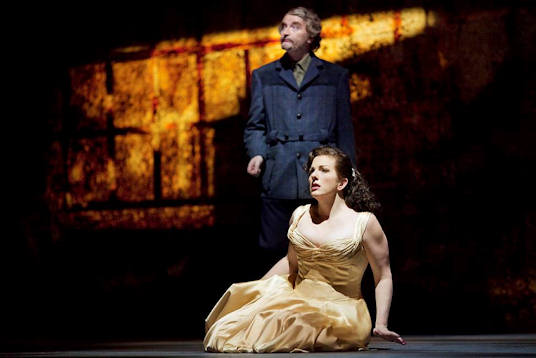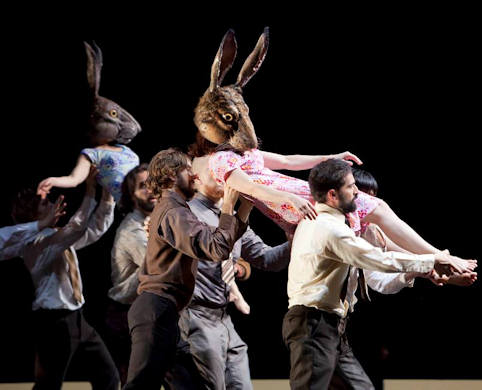Other Links
Editorial Board
-
Editor - Bill Kenny
Founder - Len Mullenger
Google Site Search
SEEN
AND HEARD UK OPERA REVIEW
Bartók, Stravinsky:
Bayley, Martens, Fabulous Beast Dance Company, Orchestra of
English National Opera/Edward Gardner 7.11. 2009(CC)
Bartók: Duke Bluebeard’s Castle
Stravinsky: The Rite of Spring

Clive Bayley (Bluebeard) and Michaela Mertens
(Judith)
On paper, one’s initial impression might be that the composers are the wrong way round. In a coupling of Bartók’s Duke Bluebeard’s Castle and Stravinsky’s Rite of Spring, surely the opera should take up the second half? And yet
on the other hand, the impact of Stravinsky’s seminal Rite remains undimmed, no matter how often one hears it, so surely it should be what rings in our ears as we leave the Coliseum? Apparently, the original plan was that the Bartók was indeed to close the evening, but technically this was not possible. Just as well – this is a stunning Rite.
First, though, the Bartók. Daniel Kramer directed Bluebeard. His award-winning Birtwistle Punch and Judy at the Young Vic was intensely memorable (where again he worked with designer Giles Cadle) and I suspect this production will linger just as long. The staging is appropriately dark, but with a multitude of intriguing touches. We enter the “castle” though a plain, suburban door illuminated by a street light (we see the door at the top of the stage later, to impress on us we are in the subterranean parts of Bluebeard’s abode). Blood is a recurrent presence; violence is the action that underpins the very ethos of this hell-hole. The resultant re-contextualisation of familiar objects is shocking. Christmas lights, representing glittering gold, are shorn of their more usual signification.
There is no prologue. The evening starts in silence: Bluebeard walks on stage; Judith follows. The music starts at their kiss. Clive Bayley’s stiffly formal Bluebeard would have kept a psychoanalyst in Porsches for a goodly while. Emotionally, and probably functionally, stunted, he breathed obsession and lack of mental balance from every pore. By painting him as a true eccentric, the staging invites us to attempt to understand this fatally flawed character, to find some sympathy for him. The arrival of Bluebeard’s children comes as a surprise. Supremely dysfunctional Von Trapps, they are just another aspect of Bluebeard’s perversions. Resonant of voice and desperate, yet unpredictable of action, this Bluebeard was intensely disturbing. Bayley’s darkly resonant voice seemed perfect. Michaela Mertens was an equally maladjusted Judith (she previously impressed as Kostelnička in ENO’s Jenůfa). She rejects Bluebeard’s advances for the secrets behind the doors. Vocally, she was resplendent, her voice only eclipsed by her dramatic presence.
Gardner never once shied away from the score’s modernity. Some interpreters soften the edges, but here the horror was never once blunted. And the most amazing part is that, despite the full staging, this remained theatre of the imagination. So much is contained in Bartók’s writing that the staging only acted as a pointer to what might be going on. That the orchestra seemed to be giving their all (remember the Rite of Spring was yet to come) is remarkable in itself. The revelation of the Lake of Tears was one of the most memorable moments, sonically.

The Rite of Spring
After Bluebeard, it seemed inconceivable that the second half could match the
opera's intensity and passion, but that was to discount the effect of Michael Keegan-Dolan’s 24-strong dance company Fabulous Beast in Stravinsky’s Rite of Spring. Keegan-Dolan was director and choreographer; designs were by Rae Smith. Keegan-Dolan sees the Rite as intensely optimistic- Spring is about rebirth, after all. Given this is a pagan rite, the sacrificial dance of the virgin is a positive societal event. The use of animal heads (extracted from cardboard boxes) for dancers - totem animal references, one assumes - brings us close to the pagan element; the falling snow of the final dance takes us to the extreme coldness of pagan Russia.
This is not a staging of the Rite for the faint-hearted. The strong sexual element includes implied gang rape, while Part I ends with a bunch of males frenziedly floor-f*cking. There seems to be a reference to West Side Story’s street fights at one point in Part I. And yet, the final Sacrificial Dance (fabulously danced by Daphne Strothmann) included marked seductive elements as well as frenzy. There was humour there, too
: I won’t spoil the “Dance of the Earth” for you.
The orchestra was red hot. The initial, beautifully reedy bassoon solo (one assumes courtesy of Simon Couzens) led to a performance that married dance rhythms to an unstoppable elemental force. Gardner’s finely-honed, supremely rhythmically controlled conducting was at once controlled yet primal.
Colin Clarke
Pictures © Johan Persson
